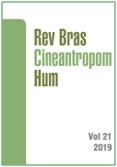Effect of number of hours and days of accelerometer use on physical activity estimates in adolescents
DOI:
https://doi.org/10.1590/1980-0037.2019v21e55973Abstract
The study analyzed the effect of number of hours and days of accelerometer use on estimates of physical activity (PA) time in adolescents. Cross-sectional study of 784 adolescents from 10 to 14 years old (53.9% girls). Overlapping 95% confidence intervals (95%CI) were used to compare mean light (LPA), moderate (MPA), vigorous (VPA) and moderate to vigorous (MVPA) physical activity times and prevalence of sufficient PA levels between different numbers of hours (?6, ?8 and ?10 hours/day) and days (?3, ?4, ?5 and 7 days of use). The criterions of ?6 hours/day with ?3, ?4, ?5 e 7 days and ?8 hour/day with ?3, ?4 e ?5 days of accelerometer use underestimated, in average, the LPA time in 23.1 and 12.6 min/day, respectively, compared ?10 hours/day. There were no significant differences in mean MPA, VPA and MVPA times and prevalence of sufficient PA levels between the number of hours and days of use analyzed. To produce accurate estimates of PA time in teenagers, ?3 days of accelerometer use was adopted for ?10 hours/day of LPA and ? 6 hours/day of MPA, VPA and MVPA.
References
Rowlands AV. Accelerometer assessment of physical activity in children: an update. Pediatr Exerc Sci 2007;19(3):252-66.
Guinhouya B, Samouda H, De Beaufort C. Level of physical activity among children and adolescents in Europe: a review of physical activity assessed objectively by accelerometry. Public Health 2013;127(4):301-11.
Cain KL, Sallis JF, Conway TL, Van Dyck D, Calhoon L. Using accelerometers in youth physical activity studies: a review of methods. J Phys Act Health 2013(10):437-50.
Romanzini M, Petroski EL, Reichert FF. Accelerometers thresholds to estimate physical activity intensity in children and adolescents: a systematic review. Rev Bras Cineantropom Desempenho Hum 2012;14(1):101-13.
Sanders T, Cliff D, Lonsdale C. Measuring adolescent boys' physical activity: Bout length and the influence of accelerometer epoch length. PLoS One 2014;9(3):e92040.
Toftager M, Kristensen PL, Oliver M, Duncan S, Christiansen LB, Boyle E, et al. Accelerometer data reduction in adolescents: effects on sample retention and bias. Int J Behav Nutr Phys Act 2013;10:140.
Trost SG, Pate RR, Freedson PS, Sallis JF, Taylor WC. Using objective physical activity measures with youth: how many days of monitoring are needed? Med Sci Sports Exerc 2000;32(2):426-31.
Vanhelst J, Fardy PS, Duhamel A, Béghin L. How many days of accelerometer monitoring predict weekly physical activity behaviour in obese youth? Clin Physiol Funct Imaging 2014;34(5):384-88.
Mattocks C, Ness A, Leary S, Tilling K, Blair SN, Shield J, et al. Use of accelerometers in a large field-based study of children: protocols, design issues, and effects on precision. J Phys Act Health 2008;5(Supplement 1):S98.
Troiano RP, Berrigan D, Dodd KW, Masse LC, Tilert T, McDowell M. Physical activity in the United States measured by accelerometer. Med Sci Sports Exerc 2008;40(1):181-88.
Troiano RP, McClain JJ, Brychta RJ, Chen KY. Evolution of accelerometer methods for physical activity research. Br J Sports Med 2014;48(13):1019-23.
Associação Brasileira de Empresas e Pesquisa ABEP. Critério de classificção econômica do Brasil: 2014 [updated November 26th, 2015]. Available from: http://www.abep.org/new/codigosCondutas.aspx.
Brooke HL, Corder K, Atkin AJ, Sluijs EM. A systematic literature review with metaanalyses of within-and between-day differences in objectively measured physical activity in school-aged children. Sports Med 2014;44(10):1427-38.
Evenson KR, Catellier DJ, Gill K, Ondrak KS, McMurray RG. Calibration of two objective measures of physical activity for children. J Sports Sci 2008;26(14):1557-65.
World Health Organization. Global recommendations on physical activity for health. World Health Organization. Geneva, Switzerland: World Health Organization; 2010.
Trost SG, McIver KL, Pate RR. Conducting accelerometer-based activity assessments in field-based research. Med Sci Sports Exerc 2005;37(11):S531-S43.
Hinkley T, O'Connell E, Okely AD, Crawford D, Hesketh K, Salmon J. Assessing volume of accelerometry data for reliability in preschool children. Med Sci Sports Exerc 2012;44(12):2436-41.
Dowd KP, Purtill H, Harrington DM, Hislop JF, Reilly JJ, Donnelly AE. Minimum Wear Duration for the activPAL Professional Activity Monitor in Adolescent Females. Pediatr Exerc Sci 2017;29(3):427-33.
Lima RA, Barros SSH, Cardoso Junior CG, Silva G, Farias Júnior JC, Andersen LB, et al. Influence of number of days and valid hours using accelerometry on the estimates of physical activity level in preschool children from Recife, Pernambuco, Brazil. Rev Bras Cineantropom Desempenho Hum 2014;16(2):171-81.
Masse LC, Fuemmeler BF, Anderson CB, Matthews CE, Trost SG, Catellier DJ, et al. Accelerometer data reduction: a comparison of four reduction algorithms on select outcome variables. Med Sci Sports Exerc 2005;37(11):S544-S54.
Van Hecke L, Loyen A, Verloigne M, Van der Ploeg HP, Lakerveld J, Brug J,et al. Variation in population levels of physical activity in European children and adolescents according to cross-European studies: a systematic literature review within DEDIPAC. Int J Behav Nutr Phys Act 2016;13(1):70.
Nilsson A, Anderssen SA, Andersen LB, Froberg K, Riddoch C, Sardinha LB, et al. Between‐and within‐day variability in physical activity and inactivity in 9‐and 15‐year‐old European children. Scand J Med Sci Sports 2009;19(1):10-18.
Cooper AR, Goodman A, Page AS, Sherar LB, Esliger DW, Van Sluijs EM,et al. Objectively measured physical activity and sedentary time in youth: the International children’s accelerometry database (ICAD). Int J Behav Nutr Phys Act 2015;12(1):113.
Aibar A, Bois JE, Zaragoza Casterad J, Generelo E, Paillard T, Fairclough S. Weekday and weekend physical activity patterns of French and Spanish adolescents. Eur J Sport Sci 2014;14(5):500-09.
Ridgers ND, Timperio A, Cerin E, Salmon J. Compensation of physical activity and sedentary time in primary school children. Med Sci Sports Exerc 2014;46(8):1564-69.



